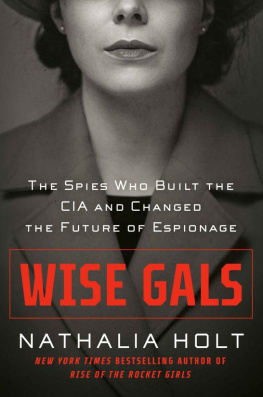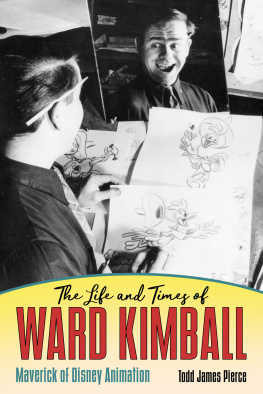Rise of the Rocket Girls: The Women Who Propelled Us, from Missiles to the Moon to Mars
Copyright 2019 by Nathalia Holt
Cover design by Lauren Harms
Cover photograph courtesy of Ben Worcester
Author photograph by Steph Stevens
Cover Hachette Book Group, Inc.
Hachette Book Group supports the right to free expression and the value of copyright. The purpose of copyright is to encourage writers and artists to produce the creative works that enrich our culture.
The scanning, uploading, and distribution of this book without permission is a theft of the authors intellectual property. If you would like permission to use material from the book (other than for review purposes), please contact permissions@hbgusa.com. Thank you for your support of the authors rights.
Little, Brown and Company
Hachette Book Group
1290 Avenue of the Americas, New York, NY 10104
littlebrown.com
First ebook edition: October 2019
Little, Brown and Company is a division of Hachette Book Group, Inc. The Little, Brown name and logo are trademarks of Hachette Book Group, Inc.
The publisher is not responsible for websites (or their content) that are not owned by the publisher.
The Hachette Speakers Bureau provides a wide range of authors for speaking events. To find out more, go to hachettespeakersbureau.com or call (866) 376-6591.
ISBN 978-0-316-43916-9
E3-20190905-JV-NF-ORI
For my happily ever after:
Larkin, Eleanor, and Philippa
The connections between and among women are the most feared, the most problematic, and the most potentially transforming force on the planet.
Adrienne Rich, On Lies, Secrets, and Silence: Selected Prose
The flower that blooms in adversity is the most rare and beautiful of all.
Mulan
When you are six years old and Cinderella arrives at the ball, you might put on a tutu and a tiara. You might dress up your baby sister in elbow-length satin gloves, their feathered ends frayed from constant use, grab her hands, slippery now that theyre encased in the flimsy pink material, and twirl around the room. You wont keep time with the music but instead wade in a childhood bliss seemingly designed for moments such as this one. At least thats what it was like at my house while I was researching this book.
There is a scene in Walt Disneys 1950 animated classic where a long, blue curtain opens, the prince sees Cinderella, and the two begin waltzing under the stars. It is the dance my daughters yearn for, accompanied by a song as familiar as any lullaby, in a film that has become part of the very DNA of their childhood.
A passion for Cinderella is not something I expected from or even sought out for them. I would never have thought a movie made more than fifty years before my children were born would provide such entertainment. Perhaps this is because I have never been a Disney fanatic. Until I began writing this book, I viewed the Disney princesses, with their fluffy dresses and vulnerable demeanors, warily, suspicious that they had been dropped into my life by unknown misogynistic forces that were bent on turning my daughters into boy-crazy women.
Princesses were mostly absent from my childhood. When I was a kid, my dad and I would walk from our apartment on Eighty-Sixth Street and Broadway in Manhattan to the Thalia Theater, a straight shot all the way up to West Ninety-Fifth Street. Every step of that walk was pure delight to me. My toes felt so light, it was as though they were flying over the pavement. Not so with my dad. As a jazz trombonist he had often worked late the night before and so he would stumble, half awake, my hand dragging him as I urged, Walk faster, Daddy. The entrance to the theater was shadowed by the buildings surrounding it, with the name Thalia, all lowercase, prominent above its marquee. I knew nothing about Greek muses, and it would be years before a teacher explained to me the lighthearted appeal of Thalia, the goddess of comedy. Yet as the word formed a portion of my own name, it seemed that the theater was a part of me.
The moment you walked in under swelling art moderne arches, you could feel the dark, cool air surround you like a cocoon. We never sat up front in the aging building but instead headed toward the back. Because of the theaters odd dipping floor, a reverse parabolic design, my dad said the view was better there. As the room became dark and the projector hummed its happy working song, I could feel the excitement building in me. In the summers, the Thalia Theater played cartoon marathons, hours of Walter Lantz, Ub Iwerks, Tex Avery, and Chuck Jones, Friz Frelengs Warner Brothers classics, Mickey Mouse and Silly Symphony shorts, and even some silent black-and-white Felix the Cat shorts from the 1920s.
They were all made many decades before I or even my dad was born. Yet I never considered their age, as the humor they contained was timeless. All I knew was that I loved Bugs Bunny, Daffy Duck, Porky Pig, and, especially, my dad, who occasionally would doze off next to me, his chest rising and falling in an easy, slow rhythm as the antics of Wile E. Coyote continued on-screen. I might not have loved princesses when I was little or sung along with Ariel, Belle, or Pocahontas, but cartoons meant the world to me.
My dad and I always stayed for the credits. It was a point of pride for him, a refusal to be rushed and a simple act of acknowledgment to the artists who made the movies. For those early cartoons, the credits were brief, so I happily watched the names scroll down the screen. One point quickly became clear: men, and men alone, made the cartoons I loved. I hunted for feminine-sounding names, but they were completely absent.
Years later, while I was researching one of my books, a woman I interviewed told me about a place she used to work in the 1930s and 1940s. The environment, she said, was electric. The artists there cared little for money or fame. Instead they wanted to create something beautiful, something the world had never seen before. The place she was referring to was the Walt Disney Studios. In her memories of this exciting time, I noted one strange factthere were many women in her stories.
When historians talk about the early contributions of women at the Walt Disney Studios, they often cite the employees of the Ink and Paint department. This female-led group traced the animators sketches in ink directly onto sheets of plastic that were destined for the camera lens and then colored them in with bright hues. The position required an inherent artistry, and it wasnt the only role women occupied at the famed studio. Before my interview in 2013, Id had no idea that women were responsible for so many of the classic Walt Disney films I love or that their influence had been largely forgotten.
I wanted to learn more and so I turned to one of the numerous biographies of Walt Disney that have been written over the years. In my eagerness, I tore through the pages, waiting for the names that I had so recently learnedBianca, Grace, Sylvia, Retta, and Maryto show up. They didnt. I turned to another biography in which two of these womens names were briefly mentioned, but their accomplishments were not. Worse, the women were referred to in patronizing terms. A famed artist who worked as an art director at the studio for decades was introduced merely in the context of her husband, as his wife, Mary. There was no indication of the magnitude of her influence at the studio. I kept hunting for traces of these artists, but despite the multitude of official histories that document the rise of Walt Disney, the contributions of the women he worked with remained unacknowledged. Dejected, I began searching out the women themselves, eager to hear firsthand the experiences that so many biographies had failed to capture.





